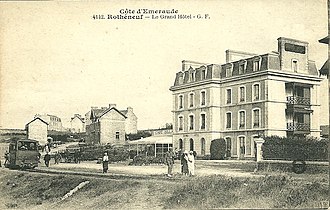Tramway de Paramé à Rothéneuf
| Tramway de Paramé à Rothéneuf | |||||||||||||||||||||||||||||||||||||||||
|---|---|---|---|---|---|---|---|---|---|---|---|---|---|---|---|---|---|---|---|---|---|---|---|---|---|---|---|---|---|---|---|---|---|---|---|---|---|---|---|---|---|
|
Route (green)
| |||||||||||||||||||||||||||||||||||||||||
| Route length: | 3.7 km | ||||||||||||||||||||||||||||||||||||||||
| Gauge : | 600 mm ( narrow gauge ) | ||||||||||||||||||||||||||||||||||||||||
| Maximum slope : | 55 ‰ | ||||||||||||||||||||||||||||||||||||||||
|
|||||||||||||||||||||||||||||||||||||||||
The Tramway de Paramé à Rothéneuf was a 3.7 km long, operated from 1896 to 1914 Decauville - steam tram with a gauge of 600 mm from Paramé (now a district of Saint-Malo ) to Rothéneuf in the Ille-et-Vilaine department in France . It ran along the coast and served as a feeder for the meter-gauge trams of Breton (fr) from Saint-Malo to Cancale .
history
The tram company Rothéneuf received the concession for public operation on November 16, 1895. The railway line was opened on June 28, 1896. At the beginning of September 1914, shortly after the beginning of the First World War, operations were stopped and the line dismantled.
Construction and dismantling of the line
This narrow-gauge railway line was built with a gauge of 600 mm. It was opened in 1896 and operated by the Rothéneuf tram company, which took over the concession granted by the department to Mr Ruellan, owner in Paramé. The 600 mm gauge was chosen because Decauville preferred it at the time. Many railways and coastal trams were built with this gauge. Since this gauge was also used by the army, it was confiscated during World War I because the military engineers wanted to reuse their tracks and rail vehicles elsewhere as a military train .
business
The operation was initially offered in the summer season, in accordance with the concession specifications from July 1 to September 30, but from 1897 additional services were offered on an experimental basis, e.g. B. Sundays and Mondays from Easter to July 1, 1897.
The coastal tram had a lot of traffic during the season. However, in order to be able to provide the services required for this volume of traffic, the concessionaire had to invest in the equipment that met the expectations of the bathers. The high cost of these investments, combined with the short duration of the profitable season, quickly led to losses in the concession company's bookkeeping, so that it did not resume operation of the line after the war.
The attempt to revitalize the street by integrating it into city traffic, as decided by the decree of July 10, 1920, was in vain. The line was therefore not rebuilt.
Rail vehicles
The concessionaire initially acquired two Decauville locomotives, each with two driving axles, but they quickly proved to be too small to cope with the hills along the route. In 1898 he therefore bought a locomotive with three driving axles, then a second in 1903 and finally a third in 1912, for which he took over the number of the second and the name of the first because he had sold the first two locomotives.
| Type and type no. | No. | Surname | Factory no. | delivery date | Remarks |
|---|---|---|---|---|---|
| 0-4-2 T Decauville Type 6 | 1 | Paramé | 215 | May 28, 1896 | Similar locomotives were used on the Tramway Royan and the Tramway de Pithiviers-Toury . |
| 0-4-2T Decauville Type 6 | 2 | Rothéneuf | 216 | June 11, 1896 | |
| 0-6-2 T Decauville Type 10 | 3 | Rochebonne | 244 | June 16, 1898 | Similar locomotives were used on the Chemins de fer du Calvados , Tramways du Tarn, and Tramway Royan . The 0-6-2T La Martroy on the Tramway de Pithiviers à Toury is a surviving example of this type. |
| 0-6-0 T Blanc-Misseron | 4th | Le Minihic | 282 | Commissioning in January 1903 | A similar locomotive was the N ° 135 Isigny of the Chemins de fer du Calvados . |
| 0-6-0T Decauville , 10 t | 2 | Paramé | 616 | April 15, 1912 |
Given the high cost of acquiring the locomotives for such a short distance, the dealer only purchased six cars, four of which had bogies and end platforms, two open summer cars, which were delivered in 1896, 1898 and 1902.
Individual evidence
- ↑ Henri Domengie: Les petits trains de jadis - Ouest de la France. Editions du Cabri, Breil-sur-Roya, 1990, ISBN 2-903310-87-4 .
- ^ Collectif: Encyclopédie générale des transports - Chemins de fer. Editions de l'Ormet, Valignat, 1992.
- ↑ KW Clingan, Jeffrey G. Lanham: Decauville Steam Locomotives: A Works List. Industrial Railway Society, 1992, ISBN 0-901096-64-4 . P. 25.
- ↑ René Hulot: Le tramway de Rothéneuf. Chemins de fer régionaux et urbains, N ° 110, 1972, pp. 48 and 38-50.


